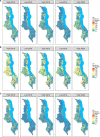Effectiveness of a national mass distribution campaign of long-lasting insecticide-treated nets and indoor residual spraying on clinical malaria in Malawi, 2018-2020
- PMID: 33947708
- PMCID: PMC8098915
- DOI: 10.1136/bmjgh-2021-005447
Effectiveness of a national mass distribution campaign of long-lasting insecticide-treated nets and indoor residual spraying on clinical malaria in Malawi, 2018-2020
Abstract
Introduction: Malawi's malaria burden is primarily assessed via cross-sectional national household surveys. However, malaria is spatially and temporally heterogenous and no analyses have been performed at a subdistrict level throughout the course of a year. The WHO recommends mass distribution of long-lasting insecticide-treated bed nets (LLINs) every 3 years, but a national longitudinal evaluation has never been conducted in Malawi to determine LLIN effectiveness lifespans.
Methods: Using District Health Information Software 2 (DHIS2) health facility data, available from January 2018 to June 2020, we assessed malaria risk before and after a mass distribution campaign, stratifying by age group and comparing risk differences (RDs) by LLIN type or annual application of indoor residual spraying (IRS).
Results: 711 health facilities contributed 20 962 facility reports over 30 months. After national distribution of 10.7 million LLINs and IRS in limited settings, malaria risk decreased from 25.6 to 16.7 cases per 100 people from 2018 to 2019 high transmission seasons, and rebounded to 23.2 in 2020, resulting in significant RDs of -8.9 in 2019 and -2.4 in 2020 as compared with 2018. Piperonyl butoxide (PBO)-treated LLINs were more effective than pyrethroid-treated LLINs, with adjusted RDs of -2.3 (95% CI -2.7 to -1.9) and -1.5 (95% CI -2.0 to -1.0) comparing 2019 and 2020 high transmission seasons to 2018. Use of IRS sustained protection with adjusted RDs of -1.4 (95% CI -2.0 to -0.9) and -2.8% (95% CI -3.5 to -2.2) relative to pyrethroid-treated LLINs. Overall, 12 of 28 districts (42.9%) experienced increases in malaria risk in from 2018 to 2020.
Conclusion: LLINs in Malawi have a limited effectiveness lifespan and IRS and PBO-treated LLINs perform better than pyrethroid-treated LLINs, perhaps due to net repurposing and insecticide-resistance. DHIS2 provides a compelling framework in which to examine localised malaria trends and evaluate ongoing interventions.
Keywords: PCR; epidemiology; malaria.
© Author(s) (or their employer(s)) 2021. Re-use permitted under CC BY-NC. No commercial re-use. See rights and permissions. Published by BMJ.
Conflict of interest statement
Competing interests: None declared.
Figures




References
-
- Kazembe LN, Mpeketula PM. Detecting geographical variability in risk of malaria-attributable morbidity using spatial models. Biomed Stat Clin Epidemiol 2009;3:43–39.
Publication types
MeSH terms
Substances
Grants and funding
LinkOut - more resources
Full Text Sources
Other Literature Sources
Medical
